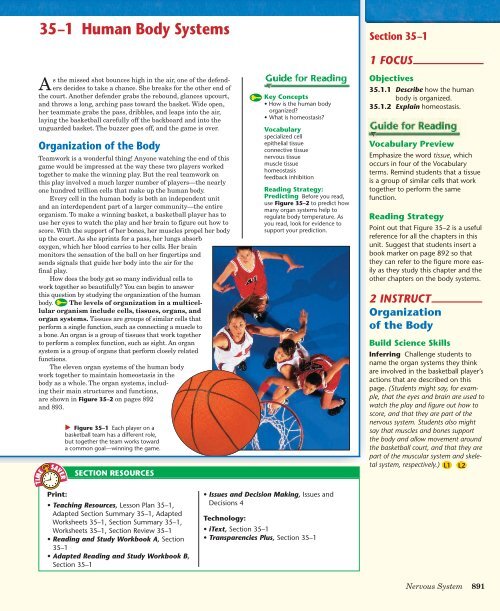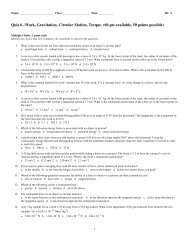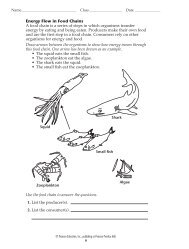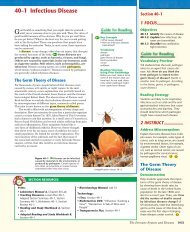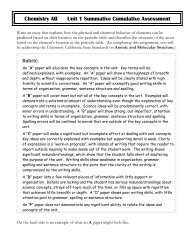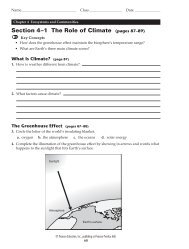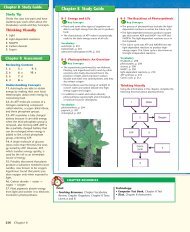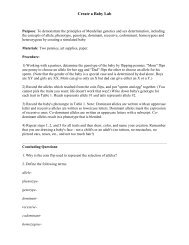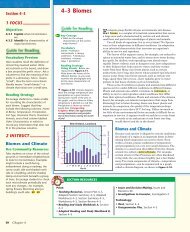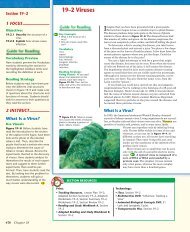Ch 35-1 Human Body Systems_ Organization - Downtown Magnets ...
Ch 35-1 Human Body Systems_ Organization - Downtown Magnets ...
Ch 35-1 Human Body Systems_ Organization - Downtown Magnets ...
Create successful ePaper yourself
Turn your PDF publications into a flip-book with our unique Google optimized e-Paper software.
<strong>35</strong>–1 <strong>Human</strong> <strong>Body</strong> <strong>Systems</strong>As the missed shot bounces high in the air, one of the defendersdecides to take a chance. She breaks for the other end ofthe court. Another defender grabs the rebound, glances upcourt,and throws a long, arching pass toward the basket. Wide open,her teammate grabs the pass, dribbles, and leaps into the air,laying the basketball carefully off the backboard and into theunguarded basket. The buzzer goes off, and the game is over.<strong>Organization</strong> of the <strong>Body</strong>Teamwork is a wonderful thing! Anyone watching the end of thisgame would be impressed at the way these two players workedtogether to make the winning play. But the real teamwork onthis play involved a much larger number of players—the nearlyone hundred trillion cells that make up the human body.Every cell in the human body is both an independent unitand an interdependent part of a larger community—the entireorganism. To make a winning basket, a basketball player has touse her eyes to watch the play and her brain to figure out how toscore. With the support of her bones, her muscles propel her bodyup the court. As she sprints for a pass, her lungs absorboxygen, which her blood carries to her cells. Her brainmonitors the sensation of the ball on her fingertips andsends signals that guide her body into the air for thefinal play.How does the body get so many individual cells towork together so beautifully? You can begin to answerthis question by studying the organization of the humanbody. The levels of organization in a multicellularorganism include cells, tissues, organs, andorgan systems. Tissues are groups of similar cells thatperform a single function, such as connecting a muscle toa bone. An organ is a group of tissues that work togetherto perform a complex function, such as sight. An organsystem is a group of organs that perform closely relatedfunctions.The eleven organ systems of the human bodywork together to maintain homeostasis in thebody as a whole. The organ systems, includingtheir main structures and functions,are shown in Figure <strong>35</strong>–2 on pages 892and 893. Figure <strong>35</strong>–1 Each player on abasketball team has a different role,but together the team works towarda common goal—winning the game.SECTION RESOURCESKey Concepts• How is the human bodyorganized?• What is homeostasis?Vocabularyspecialized cellepithelial tissueconnective tissuenervous tissuemuscle tissuehomeostasisfeedback inhibitionReading Strategy:Predicting Before you read,use Figure <strong>35</strong>–2 to predict howmany organ systems help toregulate body temperature. Asyou read, look for evidence tosupport your prediction.Section <strong>35</strong>–11 FOCUSObjectives<strong>35</strong>.1.1 Describe how the humanbody is organized.<strong>35</strong>.1.2 Explain homeostasis.Vocabulary PreviewEmphasize the word tissue, whichoccurs in four of the Vocabularyterms. Remind students that a tissueis a group of similar cells that worktogether to perform the samefunction.Reading StrategyPoint out that Figure <strong>35</strong>–2 is a usefulreference for all the chapters in thisunit. Suggest that students insert abook marker on page 892 so thatthey can refer to the figure more easilyas they study this chapter and theother chapters on the body systems.2 INSTRUCT<strong>Organization</strong>of the <strong>Body</strong>Build Science SkillsInferring <strong>Ch</strong>allenge students toname the organ systems they thinkare involved in the basketball player’sactions that are described on thispage. (Students might say, for example,that the eyes and brain are used towatch the play and figure out how toscore, and that they are part of thenervous system. Students also mightsay that muscles and bones supportthe body and allow movement aroundthe basketball court, and that they arepart of the muscular system and skeletalsystem, respectively.)Print:• Teaching Resources, Lesson Plan <strong>35</strong>–1,Adapted Section Summary <strong>35</strong>–1, AdaptedWorksheets <strong>35</strong>–1, Section Summary <strong>35</strong>–1,Worksheets <strong>35</strong>–1, Section Review <strong>35</strong>–1• Reading and Study Workbook A, Section<strong>35</strong>–1• Adapted Reading and Study Workbook B,Section <strong>35</strong>–1TimeSaver• Issues and Decision Making, Issues andDecisions 4Technology:• iText, Section <strong>35</strong>–1• Transparencies Plus, Section <strong>35</strong>–1Nervous System 891
<strong>35</strong>–1 (continued)Use VisualsFigure <strong>35</strong>–2 Review the organ systemsin the figure by asking questionssuch as: What is the function of thenervous system? (Recognizes andcoordinates the body’s response toexternal and internal changes) Whatare the structures of the integumentarysystem? (Skin, hair, nails,sweat glands, and oil glands) Whichsystem makes up the body’s supportingframework, allowsmovement, and stores mineralreserves? (Skeletal system) Whichsystems differ in males andfemales? (Endocrine and reproductivesystems)FIGURE <strong>35</strong>–2 HUMAN ORGAN SYSTEMSThe levels of organizationin the human body includecells, tissues, organs, andorgan systems. Although eachof the eleven organ systemsshown here has a different setof functions, they all worktogether, as a whole, tomaintain homeostasis.Nervous SystemStructures: Brain, spinalcord, peripheral nervesFunction: Recognizes andcoordinates the body’sresponse to changes in itsinternal and externalenvironmentsIntegumentary SystemStructures: Skin, hair, nails,sweat and oil glandsFunction: Serves as a barrieragainst infection and injury; helpsto regulate body temperature;provides protection againstultraviolet radiation from the sunSkeletal SystemStructures: Bones, cartilage,ligaments, tendonsFunction: Supports the body;protects internal organs; allowsmovement; stores mineral reserves;provides a site for blood cellformationMuscular SystemStructures: Skeletal muscle,smooth muscle, cardiac muscleFunction: Works with skeletalsystem to produce voluntarymovement; helps to circulateblood and move food through thedigestive systemCirculatory SystemStructures: Heart,blood vessels, bloodFunction: Brings oxygen,nutrients, and hormones tocells; fights infection; removescell wastes; helps to regulatebody temperatureSUPPORT FOR ENGLISH LANGUAGE LEARNERSComprehension: Link to VisualBeginning Use Figure <strong>35</strong>–2 to help studentsunderstand the levels of organization in thehuman body. Review the terms cells, tissues,organs, and organ systems. Have the studentsconstruct a concept circle with the name ofone body system in the center and the structuresand functions of that system connectedto the center by lines.Intermediate Pair ESL students with Englishproficientstudents to construct a three-columntable that describes the structures and functionsof three body systems. To do this, theycan use the information in Figure <strong>35</strong>–2. Thecolumn heads should be <strong>Body</strong> System,Structures, and Functions.892 <strong>Ch</strong>apter <strong>35</strong>
DemonstrationUse an analogy to demonstrate theimportance of communicationamong human organ systems. Assignseveral students to two small groups.Have each group work to achieve thesame simple goal, such as rearrangingthe books in a bookcase. Instruct onegroup to avoid any form of communication,including gestures, facialexpressions, and eye contact, andto work independently toward thegoal. Instruct the other group tocommunicate freely and to worktogether as a team toward the goal.Students will find that communicationand teamwork make it much easierto get the job done. Point out thatthese concepts also apply to organsystems.Respiratory SystemStructures: Nose, pharynx,larynx, trachea, bronchi,bronchioles, lungsFunction: Provides oxygenneeded for cellular respirationand removes excess carbondioxide from the bodyFULL PAGE SPREAD12 BODY SYSTEMS#4099 TKDigestive SystemStructures: Mouth, pharynx,esophagus, stomach, small andlarge intestines, rectumFunction: Converts foods intosimpler molecules that can beused by the cells of the body;absorbs food; eliminates wastesExcretory SystemStructures: Skin, lungs,kidneys, ureters, urinarybladder, urethraFunction: Eliminates wasteproducts from the body in waysthat maintain homeostasisBuild Science SkillsUsing Models Encourage interestedstudents to create an overlappingmodel of the human organ systems.First, students should trace or drawan outline of the human body. Next,they should trace the outlines of thedifferent body systems on sheets oftracing paper or transparent film.Then, they should add the structuresof one organ system to each sheet.Advise students to use colored pencilsor markers for the different organsystems and to label the structures ineach system. Allow class time forother students to examine the overlappingmodels so they can see howthe different organ systems are positionedin the body relative to oneanother.Endocrine SystemStructures: Hypothalamus,pituitary, thyroid, parathyroids,adrenals, pancreas, ovaries(in females), testes (in males)Function: Controls growth,development, and metabolism;maintains homeostasisReproductive SystemStructures: Testes, epididymis,vas deferens, urethra, and penis(in males); ovaries, Fallopiantubes, uterus, vagina (in females)Function: Produces reproductivecells; in females, nurtures andprotects developing embryoLymphatic/Immune <strong>Systems</strong>Structures: White blood cells,thymus, spleen, lymph nodes, lymphvesselsFunction: Helps protect the bodyfrom disease; collects fluid lost fromblood vessels and returns the fluid tothe circulatory systemFACTS AND FIGURES<strong>Organization</strong> of animal body plansThe general organization of animal body plans isusually taught in terms of organ systems.Students might be under the impression that allanimals, or at least all vertebrates, have the samemajor organ systems. Although this is roughlytrue in most cases, there are some interestingexceptions that demonstrate that the major organsystems are not all indispensable to animal life.For example, the tube worms found at deep-seahydrothermal vents include species in which thedigestive system has virtually disappeared. Theseworms do not eat. Instead, their digestive tractshave been reduced to a specialized organ thathouses symbiotic chemosynthetic bacteria thatproduce organic nutrients by reducing carbondioxide.Nervous System 893
<strong>35</strong>–1 (continued)DemonstrationDisplay the following items: plasticwrap, electrical wire, and packagingtape. For each item, ask: What is thepurpose of this item? (Studentsmight say that plastic wrap covers andprotects, electrical wire transmits signals,and packaging tape binds andsupports.) Explain that three of thefour types of tissues in the humanbody carry out similar functions. Ask:Which type of tissue is representedby each item? (Epithelial tissue is representedby plastic wrap, nervous tissueby electrical wire, and connective tissueby packaging tape.) What could youuse to represent muscle tissue?(Possible answers might include rubberbands or bungee cords.)Build Science SkillsUsing Models Have students examinetheir textbook to see how it isorganized into units, chapters, sections,and subsections. Ask studentsto make a concept map to show thisorganization, placing the largest subdivisionat the top and the smallest atthe bottom. Have them compare thelevels of organization in the bookwith those in complex organisms byasking: Which level of organizationin the book represents organ systems?(Units) Which levels in thebook represent organs, tissues, andcells? (<strong>Ch</strong>apters, sections, and subsections,respectively)Epithelial Tissue (magnification: 6000) Connective Tissue (magnification: about 50)Nervous Tissue (magnification: 1100) Muscle Tissue (magnification: 150) Figure <strong>35</strong>–3 The four majortypes of tissues in the human bodyare epithelial tissue, connectivetissue, nervous tissue, and muscletissue. Inferring What kind oftissue is bone?Cells A cell is the basic unit of structure and function in livingthings. Individual cells in multicellular organisms tend to bespecialized. Specialized cells are uniquely suited to perform aparticular function.Tissues A group of cells that perform a single function iscalled a tissue. There are four basic types of tissue in the humanbody—epithelial, connective, nervous, and muscle. Figure <strong>35</strong>–3shows examples of these tissues. Epithelial tissue includesglands and tissues that cover interior and exterior body surfaces.Connective tissue provides support for the body andconnects its parts. Nervous tissue transmits nerve impulsesthroughout the body. And muscle tissue, along with bones,enables the body to move.Organs A group of different types of tissues that worktogether to perform a single function is called an organ. The eyeis an organ made up of epithelial tissue, nervous tissue, muscletissue, and connective tissue. As different as these tissues are,they all work together for a single function—sight.Organ <strong>Systems</strong> An organ system is a group of organs thatperform closely related functions. For example, the brain is oneof the organs of the nervous system, which gathers informationabout the outside world and coordinates the body’s response.What is the role of nervous tissue?FACTS AND FIGURESOn more than one teamMany organs can be classified as belonging tomore than one system. The pancreas is part of thedigestive system and the endocrine system. Theheart has hormone-releasing properties, making itan endocrine gland as well as the key organ ofthe circulatory system. Bone marrow contains tissueimportant to the immune system, circulatorysystem, and skeletal system.894 <strong>Ch</strong>apter <strong>35</strong>
Maintaining HomeostasisYou can get a glimpse of the interrelationship of your bodysystems when you breathe deeply after climbing a steep hill orwhen your blood clots to seal a cut. Behind the scenes, yourorgan systems are working constantly to do something that fewpeople appreciate—maintain a controlled, stable environment.This process is called homeostasis, which means “keepingthings in balance.” Homeostasis is the process bywhich organisms keep internal conditions relativelyconstant despite changes in external environments.Homeostasis in the body is maintained by feedback loops.A Nonliving Example One way to understand homeostasisis to look at a nonliving system that also keeps environmentalconditions within a certain range. The heating system of a houseis a perfect example. In most houses, heat is supplied by afurnace that burns oil or natural gas. When the temperaturewithin the house drops below a set point, a sensor in a devicecalled a thermostat switches the furnace on. Heat produced bythe furnace warms the house. When the temperature risesabove the set point, the thermostat switches the furnace off.Because the furnace runs only when it is needed, the temperatureof the house is kept within a narrow range.A heating system like the one described is said to be controlledby feedback inhibition. Feedback inhibition, or negativefeedback, is the process in which a stimulus produces aresponse that opposes the original stimulus. Figure <strong>35</strong>–4 summarizesthe feedback inhibition process in a home heatingsystem. When the furnace is switched on, it produces a product(heat) that changes the environment of the house (by raising theair temperature). This environmental change then “feeds back”to “inhibit” the operation of the furnace. In other words, heatfrom the furnace eventually raises the temperature enough tosend a feedback signal to switch the furnace off. <strong>Systems</strong> controlledby feedback inhibition are generally fully automated andvery stable.Figure <strong>35</strong>–4 Homeostasis isthe process by which organismskeep internal conditions relativelyconstant despite changes inexternal environments. A homeheating system uses a feedback loopto maintain a stable, comfortableenvironment within a house.MaintainingHomeostasisMake Connections<strong>Ch</strong>emistry Point out that chemistryis the reason we must maintainhomeostasis in body temperature.Explain that most of the biochemicalprocesses vital to life occur efficientlyonly within a very limited range oftemperatures. Temperatures above orbelow these limits inhibit enzymesand thus chemical reactions; disruptvital functions such as breathing andcirculation; and, at extreme heat, candenature enzymes and other proteins.These all disrupt the body’sinternal chemistry.Thermostat sensestemperature change andswitches off heating systemRoom temperature increasesRoom temperature decreasesThermostat sensestemperature change andswitches on heating systemFACTS AND FIGURES<strong>Body</strong> talkTo maintain homeostasis, the body must havegood internal communication. Both endocrineand nervous systems fulfill this role in humans andin many other animals. Endocrine communicationdepends on the release of chemicals that cantravel in the blood throughout the entire body.Hours or even days may elapse between therelease of a chemical by the endocrine systemand the response by the cells that are sensitive tothe chemical. Nervous system communication, incontrast, depends on the transmission of nerveimpulses along nerve pathways, which isextremely rapid. In fact, nerve impulses can typicallyrelay information about events in one part ofthe body to the brain or another organ in lessthan a second.Answers to . . .The role of nervous tissueis to transmit nerve impulses throughthe body.Figure <strong>35</strong>–3 Bone is connective tissue.Nervous System 895
<strong>35</strong>–1 (continued)Build Science SkillsUsing Models Have studentscompare the regulation of bodytemperature in humans with the regulationof air temperature in a house.Ask: Which structure in the humanbody has the same role as thethermostat in a house? (The hypothalamus)You could extend themodel by noting that the temperaturein a house can vary with locationjust as body temperature varies fromthe core to the surface.Hypothermia means a belownormalbody temperature.3 ASSESSEvaluate UnderstandingHave students draw a simple diagramto show how the body regulatestemperature.ReteachState the function of each humanorgan system, and challenge studentsto identify the system andname its structures.Thermometer comes fromthe Greek words therme,meaning “heat,” and metron,meaning “measure.” So,thermometer means an instrumentused to measure heat. Ifhypo- is Greek for “under,”what does hypothermia mean?In the <strong>Body</strong> Could biological systems achieve homeostasisthrough feedback inhibition? Absolutely. All that is needed is asystem that regulates some aspect of the cellular environmentand that can respond to feedback from its own activities byswitching on or off as needed.Maintenance of homeostasis requires the integration of allorgan systems at all times. One example is the maintenance of astable body temperature. The body regulates temperature by amechanism that is remarkably similar to that of a home heatingsystem. A part of the brain called the hypothalamus containsnerve cells that monitor both the temperature of the skin at thesurface of the body and the temperature of organs in the body’score. The temperature of the core is generally higher than thetemperature of the skin.If the nerve cells sense that the core temperature hasdropped much below 37°C, the hypothalamus produces chemicalsthat signal cells throughout the body to speed up theiractivities. Heat produced by this increase in cellular activitycauses a gradual rise in body temperature, which is detected bynerve cells in the hypothalamus. This feedback inhibits theproduction of the chemicals that speed up cellular activity andkeeps body temperature from rising to a dangerous level.Have you ever been so cold that you began to shiver? If yourbody temperature drops well below its normal range, the hypothalamusreleases chemicals that signal muscles just below thesurface of the skin to contract involuntarily—to “shiver.” Thesemuscle contractions release heat, which helps the body temperatureto rise back toward the normal range.If body temperature rises too far above 37°C, the hypothalamusslows down cellular activities, minimizing the production ofheat. This is one of the main reasons you may feel tired andsluggish on a hot day. The body also responds to high temperaturesby producing sweat, which helps to cool the body surfaceby evaporation. Because heat from the body’s core is carried bythe blood to the skin, evaporation at the body surface also helpsto lower the temperature of the core. When this temperaturereturns to its set point, the body stops producing sweat.Students’ Venn diagrams shouldhave a nesting structure, with concentriccircles representing thefour levels of organization, fromsmallest and simplest (cells) tolargest and most complex (organsystems). Examples might includeneurons for cells, nervous tissuefor tissues, brain for organs, andnervous system for organ systems.<strong>35</strong>–1 Section Assessment1. Key Concept Sequencethe levels of organization inmulticellular organisms.2. Key Concept What ishomeostasis?3. Describe the functions of each ofthe eleven organ systems.4. What are the four types of tissue?5. Critical Thinking InferringLook at the nervous tissue inFigure <strong>35</strong>–3. Compare the cellsof the nervous tissue to the cellsof one of the other types oftissue. Which parts of an animalwould contain these types ofcells?Making a Venn DiagramDraw a Venn diagram torelate the four basic levels oforganization in the humanbody. Provide at least threeexamples for each levelincluded in your diagram.If your class subscribes to the iText,use it to review the Key Concepts inSection <strong>35</strong>–1.<strong>35</strong> –1 Section Assessment1. The levels are cells, tissues, organs, andorgan systems.2. Homeostasis is the process by which organismskeep internal conditions relativelyconstant despite changes in externalenvironments.3. Students should state the functions of eachof the eleven organ systems, as described inFigure <strong>35</strong>–2.4. The four types of tissues are epithelial, connective,nervous, and muscle.5. Answers may vary. Cells of nervous tissue, aswell as cells of each of the other types of tissues,would be found in the heart and inmost other organs of an animal.896 <strong>Ch</strong>apter <strong>35</strong>


